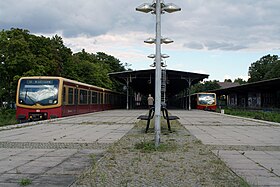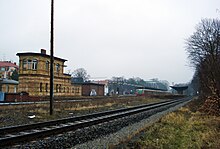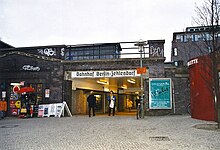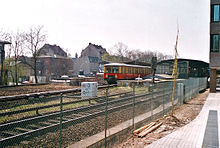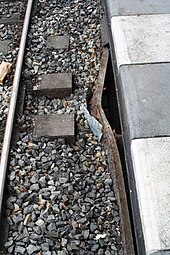Berlin-Zehlendorf train station
| Berlin-Zehlendorf | |
|---|---|
|
Wannseebahn platform
|
|
| Data | |
| Location in the network | Intermediate station , former separation station |
| Design | Through station |
| Platform tracks | 2 (S-Bahn) 1 (main line, no PV) |
| abbreviation | BZD |
| IBNR | 8089098 |
| Price range | 4th |
| opening | September 22, 1838 February 1, 1985 |
| Conveyance | September 18, 1980 |
| location | |
| City / municipality | Berlin |
| Place / district | Zehlendorf |
| country | Berlin |
| Country | Germany |
| Coordinates | 52 ° 25 '51 " N , 13 ° 15' 30" E |
| Railway lines | |
|
|
| Railway stations in Berlin | |
The Berlin-Zehlendorf train station is located in the southwestern Berlin district of Zehlendorf and is served by the S1 line of the Berlin S-Bahn . In operation Jobs Directory Berlin-Zehlendorf is as BZD out. The telegraphic abbreviation is ZD (formerly: Zfm ).
history
Steam operation
The Berlin-Zehlendorf train station is the oldest train station in Berlin today. It was put into operation on September 22, 1838 with the opening of the first section of the main line from Zehlendorf to Potsdam . Until October of the same year, the station was initially the terminus, from then on the trains ran from Potsdam via Zehlendorf to the Potsdamer Bahnhof in Berlin. Initially the station had two side platforms . Since the line was initially single-track, there was an alternative point at Zehlendorf station. Up until November 9, 1839, horses were used for traction in addition to steam locomotives .
In 1866, a half-timbered building replaced the first station building. It was located on today's Hampsteadstrasse . This created a two-storey building with a hall to accommodate travelers. Since July 1, 1874, the Wannseebahn has branched off in the western part of the station . This new route led via Zehlendorf West (today: Mexikoplatz ), Schlachtensee , Nikolassee and Wannsee to the main line at Griebnitzsee . In 1889, today's Teltower Damm was lowered under the railroad tracks. Until this redesign, rail and road crossed at ground level, which posed a high risk of accidents. In 1891 the Wannsee Railway got its own pair of tracks from the Potsdamer Bahnhof to Wannsee. The station was now called Zehlendorf Mitte . The Wannsee platform, the Zfm signal box and the freight station were built around 1891. In this way, suburban traffic was separated from long-distance traffic. The station got a new station building, a yellowish brick building , on the north side of the railroad tracks. The platform was now partly on a bridge over the Teltower Damm. The passengers reached the platform of the Wannseebahn via a central staircase.
The facilities of the Zehlendorf freight yard included the Zwt signal box, loading building, several loading streets and a locomotive shed at the western end that housed a shifting locomotive. A disadvantage of the freight station was that freight trains for Zehlendorf always had to cross the tracks of the Wannseebahn.
Between July 17, 1900 and July 1, 1902, there was an electrical test operation with 750 volts on the tracks of the Wannseebahn from the Zehlendorf train station to the Potsdamer-Wannseebahn train station in Berlin. Since the electrical test operation took place in the slow timetable of the regular steam trips, and was only carried out by a single electric train, the economic efficiency of the electric compared to the steam operation could not be proven. From 1903, the Zehlendorf station was a stopping point for the so-called banker trains coming from Wannsee from Zehlendorf from which they passed to the Potsdam station without stopping. For this purpose, the trains from Wannsee, shortly before Zehlendorf, switched from the suburban tracks of the Old Wannsee Railway to the tracks of the main line , which were long-distance tracks.
On December 16, 1907, a side platform on the main line towards Berlin was put into operation at Zehlendorf station, where the banker trains stopped. On October 1, 1909, a side platform was also opened for operations on the track out of town.
In the western part of the station, a bridge was built over the main line in 1911 in order to be able to thread the banking trains into the main line at the same level. The overpass was built on a single track, but the bridgehead was built for two bridges. A two-pronged execution was kept open, but this did not happen.
In the years 1913/1914, a second central platform was built between the tracks of the main line, which has been out of service for local public transport since September 1980 . In addition to the suburban trains of the Potsdamer Bahnhof in Berlin, all banker trains stopped at this platform.
Electrification, destruction, renaming
In the spring of 1933, construction work began to electrify the Wannseebahn and the main line from Zehlendorf. The Deutsche Reichsbahn had decided to take this step because the steam operation on the Wannsee Railway was no longer profitable. On May 15, 1933, electric railcars took over steam operation on the Wannsee Railway. The bank train operation was also switched to electrical operation. From now on the ocher / red trains of the S-Bahn rolled over the rails. Since the previous S-Bahn wagon fleet was not sufficient for the additional operation of the Wannseebahn, the 1932 type ( Wannseebahn type ) was developed and a total of 51 quarter trains were delivered.
From 1934 onwards, 14 quarter trains were used for banker trains, the 125 series, derived from the Wannsee railway car, with a top speed of 120 km / h, followed by another four quarter trains in 1938 at 140 km / h.
On October 1, 1938, the Zehlendorf station was renamed.
Since October 8, 1938, when the north-south tunnel was opened , it has been possible to travel from the Zehlendorf S-Bahn station to Oranienburg . The old terminus of the Wannseebahn, Potsdamer Bahnhof, continued to be approached by banker trains.
During the Second World War , trains for the Wehrmacht were loaded and made available in Zehlendorf . For example, freight trains for the German Africa Corps drove south. In 1943 a bomb hit destroyed the station building on Teltower Damm, and a temporary station building was built during the war. In May 1945 the Deutsche Reichsbahn temporarily suspended rail traffic.
Post-war period, construction of the wall, closure
After the Second World War, long-distance traffic on the main line was discontinued and the second pair of tracks was brought to the Soviet Union as reparations . The traffic on the Wannseebahn was resumed on June 6, 1945 to a modest extent. At first one train each morning and evening traveled the route Zehlendorf - Schöneberg , and later to Großgörschenstrasse . From July 21st there was regular operation again. The busbars and insulators of the main line in Zehlendorf were dismantled in order to repair war damage elsewhere in the S-Bahn network. From December 1945 a steam train, mostly hauled by a class 03 locomotive, commuted to Düppel on the main line . Since the locomotive could not be moved in Düppel, the shuttle train was always pushed towards Düppel. The route monitoring was carried out by a train driver who transmitted signals to the train driver from the head of the train.
Since July 27, 1947, there was a continuous connection from Zehlendorf to Friedrichstrasse station . In the summer of 1948, steam operation was discontinued and replaced by electric trains. There was a 20-minute cycle.
In 1955, the lane of the Teltower Damm was lowered again under the overpass of the train station so that double-decker buses could now also pass this point.
When the Berlin Wall was built in August 1961 , it was no longer possible to travel from Zehlendorf to Oranienburg; the trains now ended in Frohnau. The shuttle service of the main line was not directly affected by the construction of the wall and remained in place. Little changed for the Zehlendorf train station either. As since 1945, it remained under the management of the Deutsche Reichsbahn , as it had retained management (but not sovereignty over the railway facilities) in West Berlin .
As a result of the railway strike in September 1980, the S-Bahn station was closed. The shuttle traffic introduced in 1948 on the main line to Düppel and the S-Bahn traffic on the Wannseebahn had been discontinued. Access to the two platforms was not possible during the shutdown, but there was a fruit shop in the passage, which was also open during this time. In the summer of 1982 the bridge over the main line was dismantled by the Deutsche Reichsbahn and brought over the railroad to the Wannsee station and temporarily stored there. The S-Bahn line remained in operation, however, transfer trips from Wannsee to Anhalter Bahnhof led through Zehlendorf.
BVG era
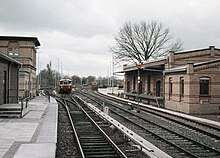
After the Berliner Verkehrsbetriebe (BVG) had taken over the S-Bahn operations in West Berlin, it was decided to reactivate the Wannseebahn. The station was in a very bad condition. The temporary station building had to be demolished in 1984 due to the risk of collapse.
The entire roof, pillars and service buildings on the Wannsee platform were completely renovated. The underpass with access to the platforms also became a pedestrian passage, the old passage to the bicycle tunnel. On the north side there was a simple entrance with a ticket office as an extension and a small tower with a clock and S-Bahn symbol. Due to the tight deadline, the platform was given a large heating tent in part in the winter of 1984/1985 so that it could continue to work in the cold. The station was put back into operation with the reopening of the Wannseebahn on February 1, 1985. The platform to Düppel, however, remained closed. The freight yard, which was run by the Reichsbahn until September 1980, served the BVG as the S-Bahn mastery from 1985.
In 1988 the 150th anniversary of the railway in Prussia was celebrated. A vehicle parade was organized for the festival on the grounds of the Zehlendorf freight station. In addition to a replica of the first commercially used German locomotive from 1835, the Adler , other rail vehicles were also on display.
After several damage caused by motor vehicles to the bridge in the 1990s, S-Bahn trains were only allowed to pass this point at 30 km / h. Around 1995 the Zwt signal box on Königsweg was demolished.
Development after 2000
From August 2002 to February 2003 the tracks of the Wannseebahn in Zehlendorf were completely renovated. A rail replacement service with buses was set up between Zehlendorf and Wannsee. The Zfm signal box was closed on February 16, 2003. Today the traffic is regulated by the signal box at Westkreuz station.
The wooden cover on the roof of the disused platform B was dismantled in November 2016 because, according to the DB, it was no longer roadworthy. Listed parts of the cover have been stored.
The station is now unsupervised, which is why the trains are operated using the ZAT procedure (train dispatch by the driver).
Occasionally, track construction trains are parked on the tracks of the freight yard. In addition, freight trains on the Lichterfelde West - Wannsee route regularly pass through the station on the freight tracks on the main platform.
Since 2010 the bridge of the Wannseebahn towards Wannsee has been replaced by an auxiliary bridge. The previous one was irreparably damaged in an accident on September 1, 2010 by a semi-trailer truck.
Expansion planning
The station is to have a second entrance. For a long time it was planned to build this when the bridge was being renewed on Teltower Damm in the western abutment . Ideas to create the second access on the west side of the train station with access from Anhaltinerstraße (Postplatz) and Machnower Straße were at times viewed with skepticism for reasons of cost, but were again specifically discussed in 2014. An additional west entrance was ordered by the State of Berlin in 2016 and is expected to be built in 2022. The preliminary planning for a connecting tunnel from Postplatz to Machnower Straße with stairs to the S-Bahn platform was completed in March 2016. This also keeps the space free for a staircase to the platform of the main line, which may have to be realized later. Deutsche Bahn was commissioned with the further planning and implementation in June 2016; a financing agreement is in preparation. At the end of 2018 it became known that the Berlin Senate had temporarily stopped the project of a connecting tunnel at Postplatz, but plans for the bridge widening at Teltower Damm and a new access to the western abutment there are being pursued.
According to the urban development plan (STEP) adopted by the Berlin Senate in June 2018, an area of around three hectares on the no longer used freight yard is to be integrated into the adjacent urban structure by 2025. Mixed use is possible on the area. a. provided with residential buildings. The existing small business is to be retained.
Connection
The station is served by the S1 line of the Berlin S-Bahn. You can change to the bus lines X10, 101, 112, 115, 285, N10, N12 and N84 of the BVG and the line 623 of the Havelbus . There is a S-Bahn ticket office in the connecting tunnel under the tracks.
literature
- Jürgen Meyer-Kronthaler, Wolfgang Kramer: Berlin's S-Bahn stations. Three quarters of a century . be.bra, Berlin 1998, ISBN 3-930863-25-1 .
- Udo Dittfurth, Michael Braun: The electric Wannseebahn. Time travel with the Berlin S-Bahn through Schöneberg, Steglitz and Zehlendorf . Ed .: Berlin S-Bahn Museum. Verlag GVE, Berlin 2004, ISBN 978-3-89218-085-2 .
- Stefan Handke: The Berlin - Potsdam railway. The Wannseebahn . Marion Hildebrand Verlag, 1988, ISBN 3-923164-07-6 .
- Berlin S-Bahn-Museum, Citizens' Initiative StammBahn: The mainline construction - division - future . Verlag GVE, 2001, ISBN 3-89218-068-7 .
Web links
- Entry in the Berlin State Monument List with further information
- S-Bahn station Berlin-Zehlendorf on stadtschnellbahn-berlin.de
- Tracks in service facilities (BZD) , DB Netz AG (PDF; Schematic track plan on the Deutsche Bahn AG website)
- Stellwerk Zfm on berliner-stellwerke.de
Individual evidence
- ↑ Station price list 2020. In: Deutsche Bahn. Deutsche Bahn, January 1, 2020, accessed on July 11, 2020 .
- ↑ 180 years ago in: Berliner Verkehrsblätter October 2018, p. 202.
- ↑ News in brief - S-Bahn . In: Berliner Verkehrsblätter . No. 2 , 2017, p. 28 .
- ↑ Auxiliary bridge normalizes traffic on Teltower Damm . In: Punkt 3 , November 25, 2010. (Accessed January 24, 2011)
- ↑ Small inquiry: New access structure for the Zehlendorf S-Bahn station. (PDF; 157 kB) Berlin House of Representatives, June 25, 2013, accessed on July 17, 2013 .
- ^ Citizens' meeting with panel discussion on customer-friendly second access to the Zehlendorf S-Bahn station on July 2nd. (No longer available online.) Archived from the original on July 15, 2014 ; Retrieved July 3, 2014 . Info: The archive link was inserted automatically and has not yet been checked. Please check the original and archive link according to the instructions and then remove this notice.
- ↑ Printed matter 17/18610. (PDF) Berlin House of Representatives, June 10, 2016, accessed on June 28, 2016 .
- ↑ Printed matter 17/19021. (PDF) Berlin House of Representatives, September 5, 2016, accessed on September 19, 2016 .
- ↑ New bridges, new entrances: The plans for the Postplatz access to the Zehlendorf S-Bahn station are on hold. In: Der Tagesspiegel . November 15, 2018, accessed January 3, 2019 .
- ↑ Ulrich Paul: On field and corridor. Where Berlin is growing: The Senate is planning eleven new residential areas. The Berliners should have a say. In: Berliner Zeitung (print edition), May 29, 2018, p. 14.
